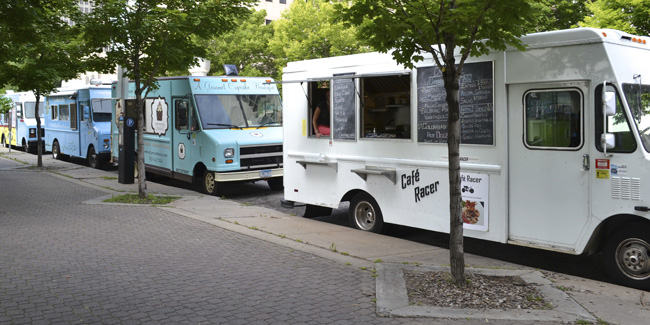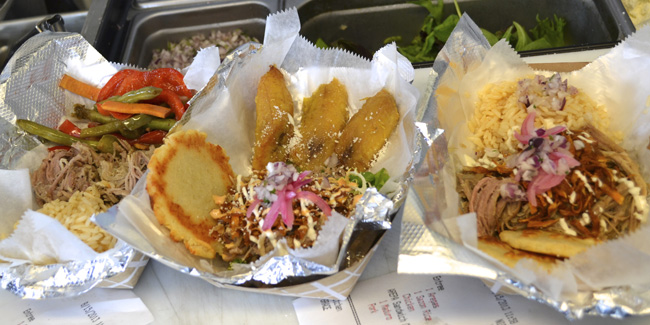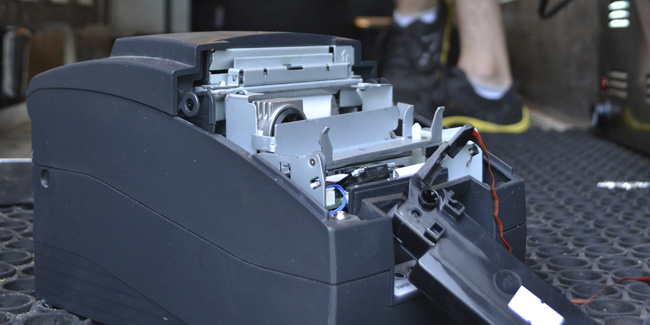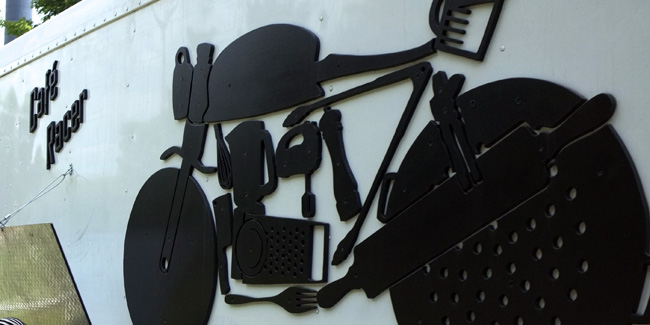
Potential customers linger at a safe distance from the window, contemplating lunch, trying to make out what exactly is served from this plain white truck that has the words “Cafe Racer“ emblazoned on its side. Nicole, a smiling presence in the order window with a tight red ponytail and extravagantly manicured fingernails, cheerfully hands out paper menus. A man, his mugshot visible on an access card hanging from his belt, bravely sidles up to the window. Questions about the food arise and are answered brightly, and an order is placed. “Pork entree with souffle and veggies,” Nicole shouts to the bandanna’d Tony, who tears a ticket off a printer that enumerates the same. Tony begins assembling the order at the steam table. A moment later and three feet down the line, Luis Patino, owner and proprietor of the Cafe Racer food truck, puts the finishing touches on the heaping paper boat of food and hands it out the window to his first customer of the day. The guy smiles, grabs a napkin, and heads toward the park to chow down. The first meal of a 14-hour day is served.
So what was in that paper boat? A heaping pile of braised pulled pork, topped with an artful crosshatch of cilantro-laced crema and “pink sauce,” and garnished with crunchy shoestring sweet potatoes, pickled onions, and pico verde. Nestled next to that, a serving of balsamic vinegar-roasted veggies (red and green peppers, green beans, onion and sweet potato, all julienned attractively), and a muffin-shaped carrot souffle. The whole plate is an explosion of Crayola hues, and it’s Patino’s take on the food he grew up eating in his native country of Colombia before emigrating to the U.S. as a kid. The grand total for this bulging plate is $8.
“The idea is to take the simplest ingredients available and prepare them with the most flavor possible,” says Patino. “This food is directly influenced by the peasant-style food I grew up eating, which has its own long history. This is the food my mother and grandmother made, every day. It’s comfort food for me.”

The menu is divvied up into Entrees (choice of pulled pork or chicken and 2 sides) for $8, Arepa Sandwiches (choice of meat and one side) for $7, a salad of mixed greens (your choice of meat and all the garnishes) for $7, a pair of “Colombian Street Dogs” (Nathan’s hot dogs topped with all the fixings) for $7, and a menu of side plates for $3 each: carrot souffle, sazon rice, roasted vegetables, sweet plantains, and cheesy arepas.
Sounds good, but the proof, as they say, is in the pudding. Not 10 minutes later, the first customer returns to the window with some kind words about his lunch. Patino smiles, thanks the guy, and turns back toward an order of his Colombian Street Dogs that are waiting for garnishes. “It’s super rewarding when people come back and rave about the food. It’s great to hear,” he says.
What, exactly, did it take to bridge the gap from the very first tickle of an idea to start a food truck, to getting a plate of Colombian-style comfort food into the guts of that happy customer? We spent a day riding along with Cafe Racer to find out.
Earlier in the day, we met Patino at his home in the Lyn-Lake neighborhood of Minneapolis at 8:30am. His wife and business partner, Christine, a Minneapolis police officer with a beat in the neighborhood, prepped a breakfast smoothie for Patino and sent us on our way. She puts in about 10-15 hours per week on the truck, but wouldn’t be joining us today. Our first stop of the day wasn’t far.
“We’re really lucky that our friends at Tiger Sushi give us space in their kitchen,” Patino explained as he unlocked the back door to the restaurant on Lyndale Avenue, which serves as the offsite prep kitchen for his truck. “It’s definitely a challenge for truck owners to find usable commercial kitchen space in the Twin Cities,” he says. We follow him to a small corner of the large walk-in cooler, where one shelving unit holds all of the food that he’ll serve for the day. It had been prepped from midnight to 6am by two of his crew, and it’s all neatly organized, wrapped, and ready to go. Patino loads up a handcart with the plastic-wrapped six-pans of food. We make a quick pit stop at the dry goods shelf to grab paper boats and napkins, and then it’s out to the truck — parked near the Midtown Greenway bike trail and standing serenely against the rising summer sun — to load up and move out.

The truck shudders to life, and the journey begins. For all of our familiarity with food trucks from the outside, it’s a different world on the inside. It is not an elegant, sleek affair. It’s a squeaking, clattering pirate ship on wheels, where bungee cords stand in for rigging, ovens for cannons, and everything is strapped down in anticipation of rough waters. It’s immediately apparent that a good truck has to be designed with maximum efficiency in mind. Patino and his partners spent months gutting the truck and rebuilding it from scratch, custom fabricating everything to their specific needs. From bow to stern, on the port side of the truck, is a stainless steel prep table, with shelves above and below; the main prep line, with cutting board and lowboy fridge; the steam table, which sits atop a steel table with storage below; a four-burner range and oven; and a small prep table with storage beneath.
Up above this side is an impressive hood and exhaust array, with a built-in fire suppression system. Along the starboard side, which is the service side of the truck, there’s a triple-well prep sink, a handwashing sink, the main service window, a steel table where the POS (point of sale) system sits along with service items (utensils, napkins, etc.), the smaller ordering window, and a steel table with a beverage cooler on top. It’s a real-deal commercial kitchen in miniature.
Patino is obviously proud of how solidly his truck is built. As we careen onto the freeway toward St. Paul, he points triumphantly. “See that can of Coke on the dash over here? It hasn’t even moved!” He shouts over the road noise. True enough. “When I bought this truck, we found a sneaker wedged into each side of the rear suspension. One fell out last week, and the squeaking has been crazy. The shoes were in there for a good reason!”
At that moment, a distinct crunch is heard from the back of the truck, standing out amid the general clatter and squeak of jostling kitchen equipment. Patino jerks his head toward our way, riding shotgun in a tiny jumpseat with the door open and the blacktop of eastbound Interstate 94 screaming by at 65 mph just below.
“That didn’t sound good!” he says cheerfully.

A ticket printer, perched atop the beverage cooler in the aft / starboard corner of the truck, had leaped to its doom, and laid in pieces on the rubber nonslip floor mat. Man overboard.
“Ah, we’ll figure it out.”
Patino is a relentlessly optimistic presence, a whippet-lean rubber band of constant motion and energy topped off with a stylin’ driver’s cap. A second generation immigrant, he nursed a dream to serve up his homeland’s comfort food while working for multiple jobs in a suit and tie as a paralegal. After years of planning, this is the first full season of business for Cafe Racer.
He maneuvers the truck into its permitted space on Kellogg Boulevard, just west of Robert Street in downtown St. Paul. The morning sun is shining over the river, and three other trucks fall in line behind Cafe Racer with their service windows aimed at the park: A Cupcake Social, Neato’s, and Home Street Home. These four trucks gather here every Thursday for St. Paul’s Lunch By The River. As they pull up, Patino talks about the unique fellowship found among truck owners, where mutual support seems to be the rule, even amid heavy competition.
“You’ve got to find that competitive edge,” he says. “I’m extremely focused on the numbers. But the food truck industry is very different from that of brick-and-mortar restaurants or almost anything else, for that matter. There is a lot of camaraderie — you need to work together to make money; you can’t be the lone wolf out there and think that it’s gonna just work out for you. It won’t.”
Why won’t it work? Compared to other cities with more progressive food truck laws, Minneapolis and St. Paul are fairly restrictive, with limited locations where trucks are allowed to do business. This creates some strife among truck owners just trying to find a coveted space along Marquette Avenue in downtown Minneapolis, for instance, and also invites finger-pointing from failing Skyway restaurants who blame the trucks for their decline in sales. “You have to collaborate with the other trucks, make friends, and be part of the community,” says Patino. “There’s plenty of competition, sometimes it can get tense, but at the end of the day we all want each other to succeed, and there’s plenty of business to go around. It’s important to keep an open line of communication going.”
So why the guff from Skyway restaurants? Patino thinks most of them simply can’t compete on quality, which is the intrinsic nature of fast food and chain spots — the owner of Taco John’s isn’t at the Minneapolis Skyway location to ensure that every taco is perfect (though it’s doubtful any managerial intervention could achieve such a feat). “Food trucks are more likely to be small businesses with direct involvement from the owner, which just leads to a better product,” he says. “People want a more direct connection to their food … the nature of running a truck business demands a more direct and hands-on approach from the owner.”
Once the truck is nestled against the curb, Patino pops the back door and surveys the damage. It doesn’t look good. With the air of someone who’s improvised before, he scoops up the fallen printer and begins tinkering. After a few minutes, he seems to have it reassembled, and after plugging it back in and starting up his POS system, the printer miraculously lights up and spits out a ticket like nothing ever happened. High fives are shared, and it seems like a good omen for the rest of the day. “I honestly thought there was no way that thing was coming back,” he says.

The floor of the kitchen is crammed with all manner of bins and hot / cold boxes. Patino calls this part of the day Truck Tetris, and its easy to see why: Everything needs to find its proper place, and he’s got a system. In short order, the floor clears, the cab fills in with empty boxes, appliances appear from beneath all the cargo, and it starts to look like a real kitchen — one with a surprising amount of space for people to work within. We head outside to fire up the generator, which is cleverly tucked under the truck on a slide-out shelf. The Honda generator purrs to life quietly, the lights blaze forth in the kitchen, and the low hum gets promoted to a soft vibration as the the steam table clicks on. Next comes the gas, attached to the stern of the truck in a large tank. Pilot lights get lit underneath the oven, and the prepped food goes in to get heated up to temperature.
He explains the process: “In the beginning, I was trying to make everything from scratch on the truck, and it was just no good. It’s far more efficient to prep everything offsite, and then fire everything to order here on the truck. We learned a lot about efficiency early on. It took a long time for me to figure out how to get everything ready to go, by myself, in 90 minutes.”
Prep continues, with Patino marching through the process he’s refined through months of trial and error. Arepas get topped with cheese and tossed into the oven, the steam table gets loaded with pulled pork, chicken, veggies, rice, plantains, and those carrot souffles. Throughout the hustle of getting things in order, he confides about the challenges of getting started.
It was about 4 years ago, in his third paralegal job after graduating from Hamline University, when he started thinking about a change. “I started to realize that I wanted to do something for myself,” he says. “I wasn’t 100 percent sure what that was at the time, but I was lucky to have a lot of good mentors and friends that guided me and helped me focus.”
One mentor in particular, a successful local businessman, showed Patino the ins and outs of creating a business plan and talking to banks. “He told me that I’d go to five or six different banks, and that they’d all laugh at me. He was exactly right. It really doesn’t matter what you’re trying to do — a business is a business, and banks just look at the numbers. The numbers that they want are a one-to-one ratio. I’d come with a plan, and every time, they’d say, ‘I’m sorry, your numbers don’t add up; there’s no way we’re going to give you all this money that’s not secured.’ So, it basically took me a really long time to save up a 20 percent down payment for a $45,000 loan. I sold two motorcycles and worked to save the rest. Point is, there are a lot of sacrifices you have to make to simply get the idea off the ground.”
As the lunch service prep continues, the smell of the braised meat starts filling the truck. The browning masa cakes start making their presence known, too. Patino continues to lay out the history of conceiving his business.

“From the moment I finished my business plan and felt comfortable approaching the banks to getting the loan, it took about 8 months, and I went to 7 or 8 banks. There’s a big difference from saying, ‘Hey, I really want to start my own business someday!’ to making the choice that says, ‘This is it, we’re doing this, it’s happening, there’s no going back.’ Me and my wife really had to make that choice together. I gave up so, so many times. If not for her, I would have quit — it’s a team thing. The moral support is huge.”
The smells in the truck start making both of us hungry. As Patino whirls around checking temps and stocking up on forks, napkins, and the other service accoutrements, he claims that he “gets sluggish” when he’s hungry. It’s hard to tell. Anyway, there is plenty of food to eat, so eat we do. He plates up a typical entree from the menu: a generous serving of the pulled pork and a choice of sides. We choose the plantains, rice, and the carrot souffle. The pork is moist, tender, and scented with cumin and bay leaf. The garnishes of aiolis, pickled onions, pico de gallo, and shoestring potatoes are modest, and add welcome contrasts — crunch, acidity, fat, and sweetness. The sazon rice is flavorful, and the plantains are a simple, sweet accompaniment. But the star of the sides is the carrot souffle. Prepared in a muffin pan, the small orange puck is a barely held-together nest of shredded carrot, cream, and cheese. It’s unexpectedly delicious: naturally sweet from the carrots, deeply vegetal, creamy. It’s the sort of thing that we could imagine being a hit at the State Fair if served on a stick and deep fried.
“I started being serious about this whole venture on January 1, 2011,” he says. “It was literally a New Year’s resolution, like, ‘I am going to do this for myself. I want to work for myself.’ Being an immigrant, it’s a really important perspective – I’ve always really looked up to the opportunities that I might not have had if my parents hadn’t made the sacrifices to stay here … Honestly, this stuff, I’m making it sound way harder that it is. In the end it’s just paperwork, talking to a bunch of people, putting in the footwork, educating yourself. Anybody can do that. The hard part is just the follow through. Sometimes, you get to the point where you just can’t even imagine filling out two stupid forms and bringing them downtown, or something small like that. That’s the struggle. It really takes a team — my wife, my friends and mentors. I really believe in the concept of the tribe. Going through the whole process, starting your own business and finally getting here … it feels surreal sometimes.”
TOMORROW IN PART TWO: “There’s not an instruction manual for this,” booming labor costs, and “living the dream.”
